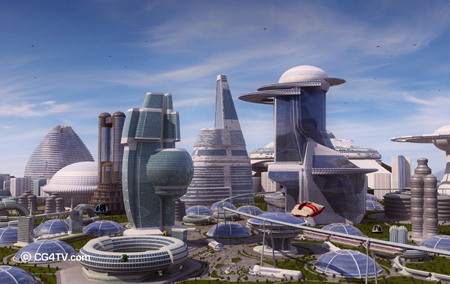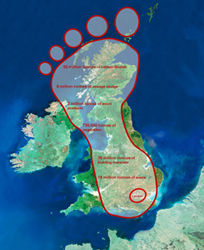2. Urbanisation
The future of the city - a sustainable city?
Cities occupy only 2% of the world's land surface but use over 75% of the world's resources (Battle 2007). They consume about 75% of the world's energy and contribute an equivalent amount to global pollution. Urbanisation is linked to resource depletion, increased waste and pollution, and the reduction of species. On average, each city of 1 million people daily consumes 625,000 tonnes of water, 2,000 tonnes of food and 9,500 tonnes of fuel, and generates 500,000 tonnes of waste water, 2,000 tones of solid waste and 950 tonnes of air pollutants (Pacione 2001).
The Future in Europe?
Old, poor and lonely, this is the bleak outlook that threatens many people in the middle of a worldwide growing and aging population. The city planner Albert Speer urges: "We have to design cities and regions of short distances, we have to prepare our cities for an aged community!"(Latz 2007).

Source: Nextconceptcars.com
The imagination of the family-adverse city life needs to be corrected and a new model of "family friendly and child-oriented living" for areas close to the city centre has to be developed. The sustainability of future cities lies in the mixture of various spheres like living, working, leisure, health, culture and consumption in confined spaces. One way to reduce travel needs would be to concentrate homes, jobs and services in a relatively compact urban centre to achieve high levels of accessibility with a reduced need for movement (Pacione 2001).
Concentration of development in existing urban centres may also contribute to their rehabilitation and revitalisation (Pacione 2001). In order to provide room high-rise buildings are constructed (Latz 2007).
Any future urban model must be sustainable. The concept of sustainable development is based on the three principles: Inter-generational equity, social justice and transfrontier responsibility (Pacione 2001). The cities of the future will have to be significantly "better", or what has become known as Planet Positive. This will involve four key changes for cities:
- producing more energy than they need
- becoming net carbon absorbers
- collecting and processing waste within city limits
- collecting and cleaning recycled water.
All this should happen parallel to the creation of wealth and the promotion of social well-being and individual health (Battle 2007).

Source: London.gov.uk
Ecological footprint
The ecological footprint calculates the area a person needs to make his or her lifestyle possible. The decisive factor is energy consumption and utilization of resources in the everyday life of the particular person. On average, the ecological footprint of a German is 4.7 ha per year, and if everyone lived at that level of consumption would humanity need 2.5 earths. The area of London is 158,000 ha, however its ecological footprint amounts to 19,700,000 ha and is therefore 125 times bigger than London itself (London.gov.uk).
The World Commission on Environment and Development forecast in 1987 an increase in global energy consumption from the equivalent of 10 billion tons of coal per year in 1980 to 14 billion by 2025, allowing for a population increase from 4.5 billion to 8.2 billion (Pacione 2001).
According to the calculation of the International Energy Agency the energy consumption will rise worldwide by about two-thirds until 2030. Energy will be more and more expensive and in short supply. Cities are the living spaces of the future and they are also the focus areas of energy consumption. Therefore a resource-friendly handling is needed (Latz 2007). The challenge of the future is to satisfy the urban hunger for energy, but at the same time not to risk the economic livelihood. City planners will need to focus on modern energy efficient techniques, to power the cities sufficiently in a resource-friendly and cost-saving manner (Claaßen 2008).
Tasks: 1a. Follow the link http://earthday.net/footprint/flash.html and calculate your personal ecological footprint.
1b. Compare your "footprints" in class and discuss individual possibilities to act.
2. Collect your own ideas of a sustainable and liveable city of the future in small groups.